297 Products
-
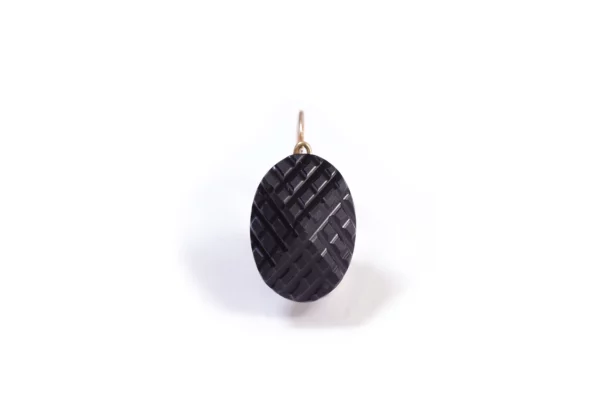
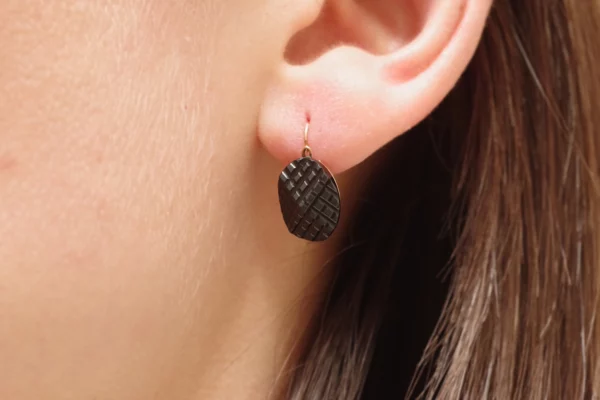 140,00€
140,00€Single black dormeuse earring in 18 karat rose gold (750/1000). Unique dormeuse earring decorated with black glass imitating jet, known as “verre de Paris.” The glass is pointed and decorated with a grid pattern. Antique single earring, circa 1830, France. Unmatched piece.
Hallmark: ram’s head (1819-1838, french state hallmark for 18 karat gold)
Height: 18 mm
Width: 9 mmCondition: wear and tear. This earring is sold individually.
Weight: 1.31 gr
-
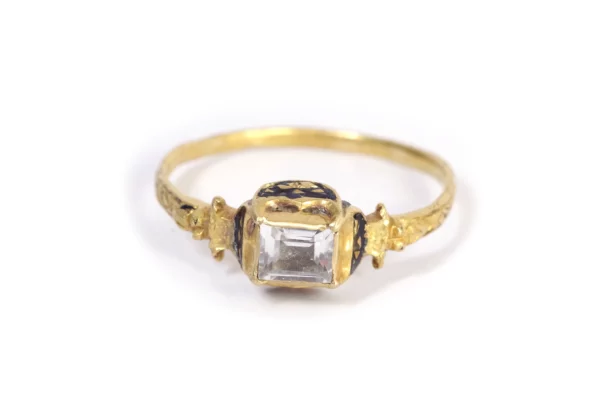
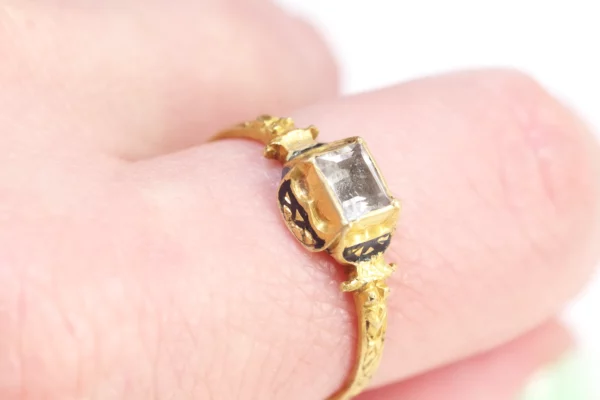 Out of Stock
1,00€
Out of Stock
1,00€Scarce rock crystal Renaissance ring in 22 Karat gold. This 16th-century ring is setted with a table-cut rock crystal in a closed setting. The bezel is decorated with black enamel with gold highlights and double crescent motifs, ending in four prongs. The shoulders feature fine chiseling. Renaissance ring from the 16th century, Western Europe. During the Renaissance, rings evolved from the simple forms of the medieval period to miniature works of art, combining the skills of the chiseler, engraver, enameler, and stone cutter. Cabochon settings persisted, but the evolution of stone cutting allowed for the increased use of table cuts.
Ring size: 57 EU or 8 US
Bezel dimensions: 7 x 8 mm
Estimated weight of the rock crystal: 0.49 ct
Note: For examples of similar 16th-century rings, see items 334 and 430 in Scarisbrick’s “Rings; Jewellery of Power, Love and Loyalty” (2007); item AF.1743 in the British Museum collection and items 279 and 281 in the “Victoria and Albert Museum Catalogue of Rings” by Oman (1930).
Condition: normal wear consistent with age, a missing part in the setting.
Weight: 2.91 gr
-
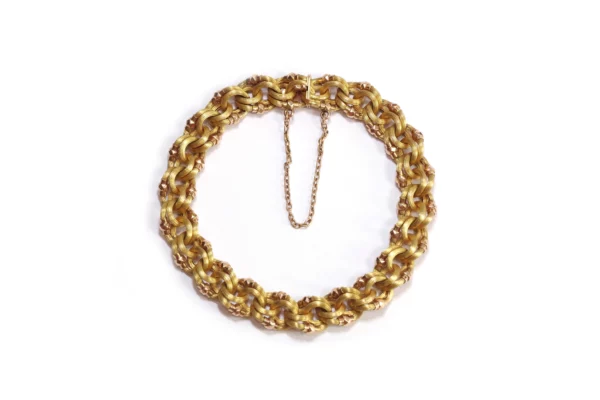
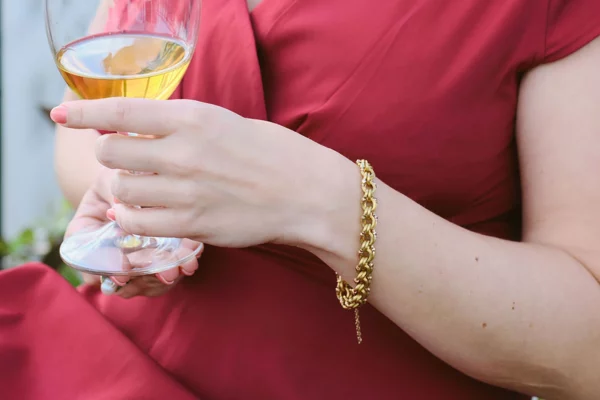 2000,00€
2000,00€Antique Antillean bracelet in 18k yellow gold. Antique bracelet composed of twisted links forming grooved rings decorated with faceted spherical motifs. Antique bracelet from the Antilles, circa 1880, France.
Hallmarks: eagle’s head, rhinoceros head, and maker’s mark.
Length: 19.5 cm
Width: 10 mmNote: the clasp is secured by an 18 karat gold safety chain.
Condition: minor wear and tearWeight : 17.71 gr
*The antique box is not sold with the jewel*
Further information : Traditional jewelry is still worn in the Antilles for special occasions and cultural events. This regional Antilles jewelry is characterized by elaborate motifs such as twisted gold wires, vine leaves, forçat mesh, fluting, “gros sirop” mesh, gold wire spirals, etc.
-
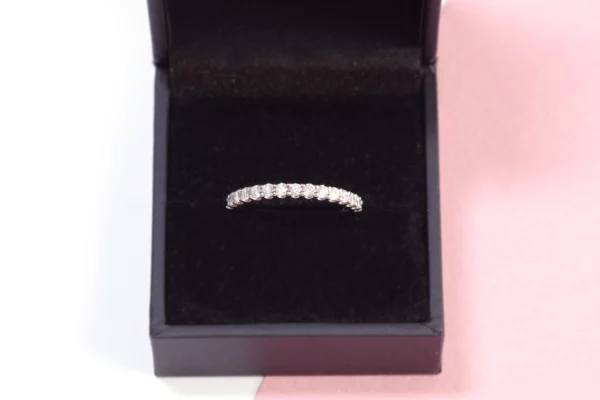
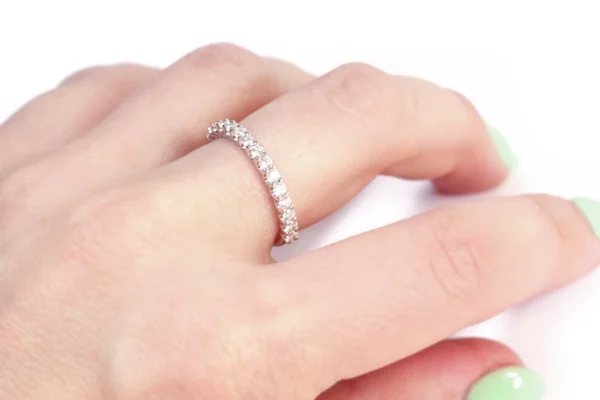 900,00€
900,00€Half-eternity band in 18 karat white gold. Half-eternity ring set with 15 round brilliant-cut diamonds on a white gold mount. Vintage band from the 20th century.
Hibou hallmark (french state hallmark for 18 karat gold), 750 hallmark
Finger size: 53 EU or 6.25 US (resizable)
Total diamond weight: 0.51 carat
Condition: signs of wear
Weight: 2.44 gr
-

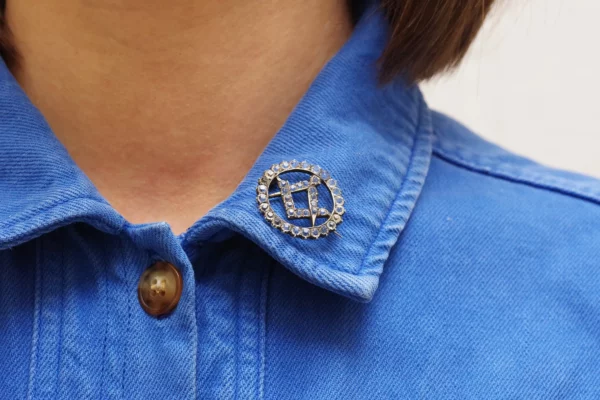 450,00€
450,00€Antique Masonic brooch in silver. Masonic brooch featuring the Square and Compasses within a circle, set with rhinestones. The combination of the Square and Compasses forms a square within the circle, symbolizing matter surrounded by the spiritual. The reunion of body and spirit can be supported by the quest for the squaring of the circle. In Masonic believes, the Compass symbolizes spiritual measurement and the individual’s ability to keep their actions within the bounds of what is right and appropriate. It also represents the capacity for self-assessment and improvement. The Square, on the other hand, represents the virtue of living a straight and balanced life, while respecting moral and ethical laws. Antique brooch, circa 1900.
Swan hallmark (french state hallmark for silver)
Diameter: 26 mm
Condition: signs of wear
Weight: 3.76 gr
*The antique gold chain is not sold with the jewel*
-
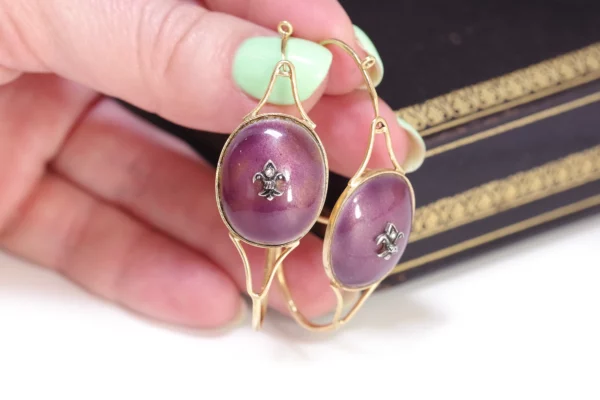
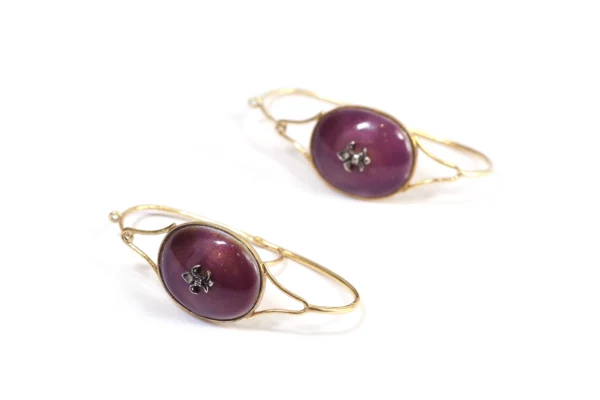 2500,00€
2500,00€Large French enameled poissardes in 18k yellow gold. Large pair of earrings called “poissardes” adorned with an oval-shaped purple enamel motif. In the center, a silver fleur-de-lis is inlaid on the enamel and set with a rose-cut diamond. French earrings, early 20th century, France.
Eagle head hallmark (French state hallmark for 18 karat gold), B59
Height: 5 cm
Width: 1.8 cmFleur de lys dimensions: 6 x 5 mm
Condition: slight wear scratches, enamel restoration (invisible to the naked eye).
Weight : 11.62 gr
*The antique box is not sold with the jewel*
-
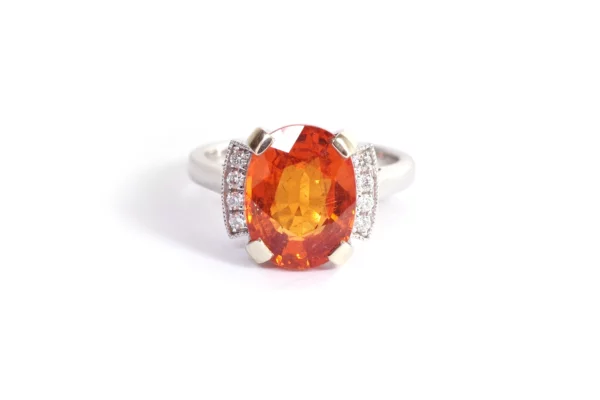
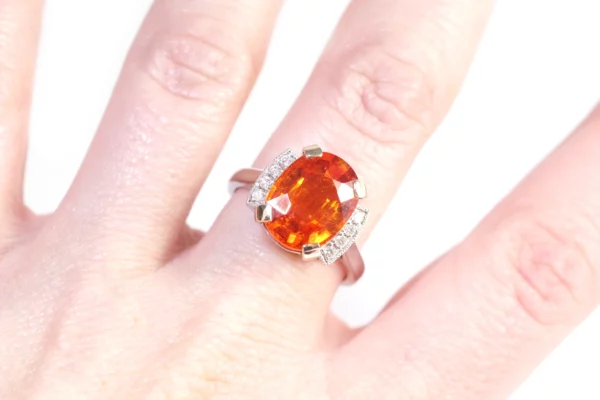 3200,00€
3200,00€Mandarin garnet ring in white gold 18 karats (750). The ring is centered with an oval mandarin garnet (also called spessartite), with an intense orange color. The garnet weighs approximately 6.84 carats. The garnet is set with four prongs and flanked by eight brilliant-cut diamonds. Vintage ring, circa 2000, United Kingdom.
Hallmarks: 750 AU, XM, and other English hallmarks.
Ring size: 53 EU or 6.25 US (resizable)
Dimensions of the ring head: 13 x 14 mm
Dimensions of the mandarin garnet: 12.42 mm x 9.55 mmEstimated weight of the mandarin garnet: 6.84 cts
Estimated weight of the diamonds: 0.12 ctCondition: light signs of wear
Weight: 6.90 gr
*The antique box is not sold with the jewel*
-
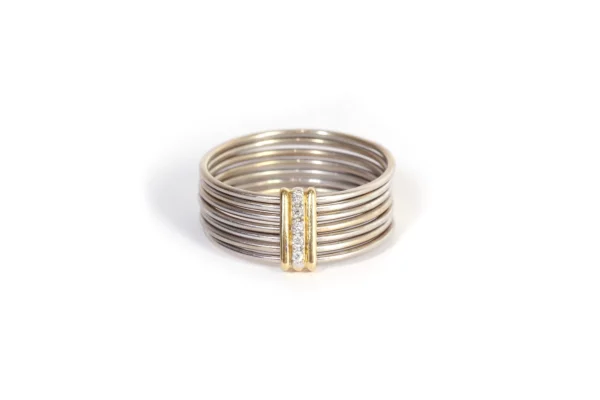
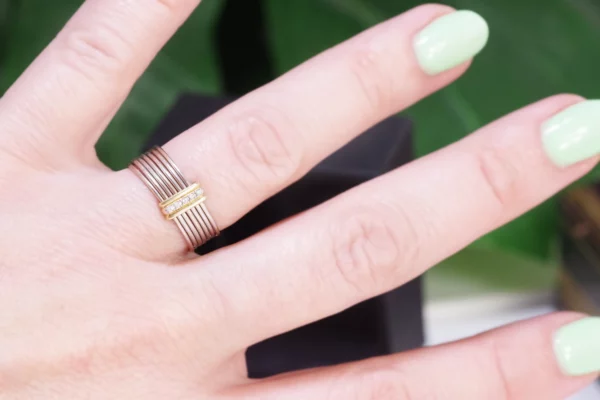 700,00€
700,00€“7 péchés de toi” Mauboussin ring. Vintage ring signed Mauboussin from the 2014 collection. Ring composed of seven white gold rings linked by a yellow gold band set with five brilliant-cut diamonds. Pre-owned ring, 2014, France.
Owl hallmark, mark 750, Mauboussin signature, goldsmith’s mark, numbering.
Finger size: 49 EU or 5 US (no sizing possible)
Width: 7 mm
Estimated diamond weight: 0.05 ct
Weight : 3.09 gr
*The antique box is not sold with the jewel*
More information : “Les 7 péchés de toi” whose advert was “You, you, you, you, you, you, you again, but a life without sin would not be worth living, believe me”.
-
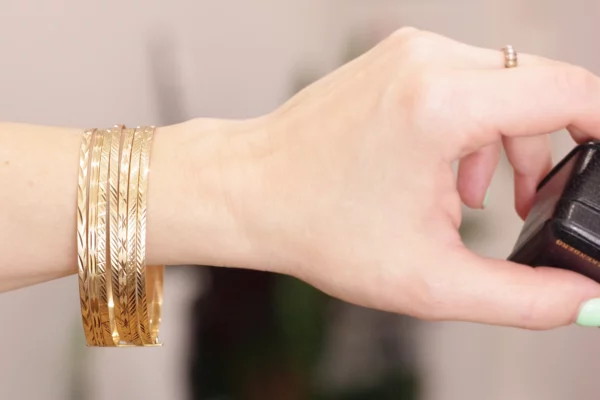
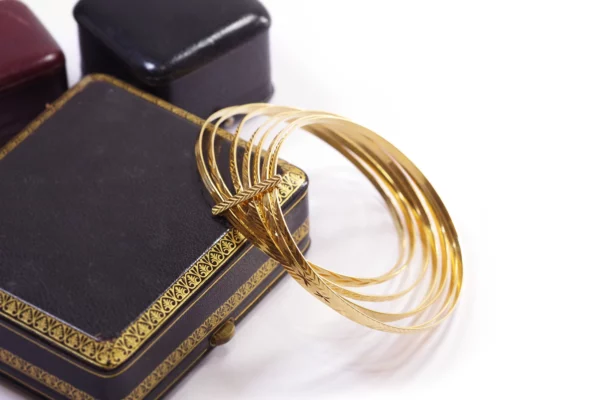 3600,00€
3600,00€Gold semainier bracelet in yellow gold 18 karats. The bracelet is composed of seven large rings symbolizing the days of the week, united by a bar. The rings are engraved with geometric patterns. Vintage bracelet, circa 1990, France.
Eagle’s head hallmark (french state hallmark for 18 karat gold) and French maker’s mark (Andreassian)
Wrist size: 19.5 cm
Inner diameter: 6.5 cm
Width: 2.4 cmCondition: light signs of wear
Weight: 39.72 gr
*The antique box is not sold with the jewel*
-
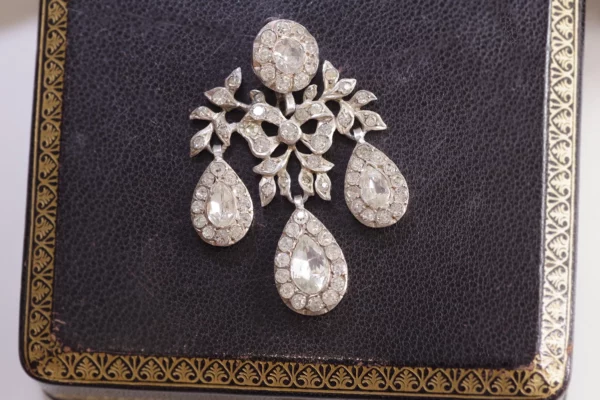
 700,00€
700,00€Victorian silver girandole pendant in silver 800. A girandole pendant forming a large knot holding three drops in the style of late 18th-century jewelry. The entire piece is set with white paste stones on foils. Victorian period, circa 1860-1880, France.
Boar hallmarks (french state hallmark for silver)
Height (with setting): 50 mm
Width: 33 mmCondition: fine wear scratches
Weight : 11.31 gr
*The antique box and the chain are not sold with the jewel*
See our antique chains -
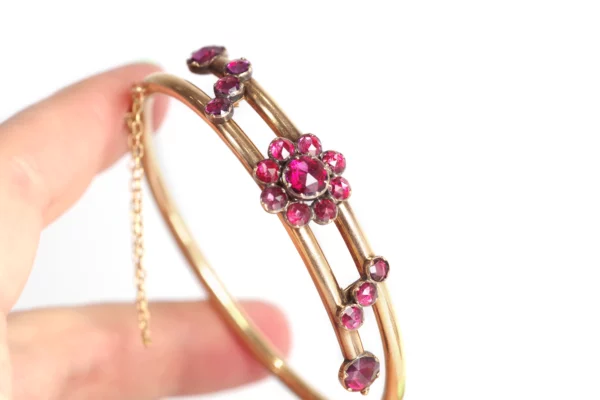
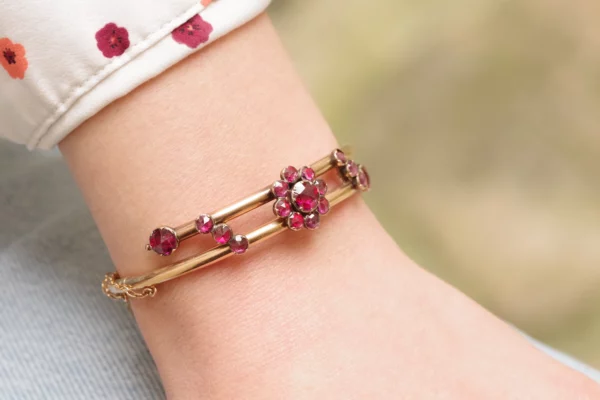 2600,00€
2600,00€Perpignan garnet bangle bracelet in 18 karat rose gold. Bangle bracelet featuring a rose gold hollow stem, the ends decorated with garnets. In the center of the bracelet, a flower formed of 9 round garnets, and on the sides a barrette motif formed of 3 garnets. The stones are “Perpignan” cut, a rose cut with a flat base. They have a beautiful raspberry-pink-red color, typical of Perpignan garnets. The garnets are mounted on foil and in closed setting. The setting is delicately decorated with triangular V-shaped figures on the edges, and the bezel backgrounds are domed. The clasp is a box-latch secured by a chain. Antique rush bracelet, circa 1880, Southeastern France.
Horsehead hallmarks (1838-1919, french state hallmark for 18 karat gold)
Center width: 14 mm
Inside length: 16.5 cm
Inside dimensions: 5 x 5.5 cmCondition: slight wear scratches, small dents behind two bezels, a inner crack in one of the garnets.
Weight : 9.96 gr
-
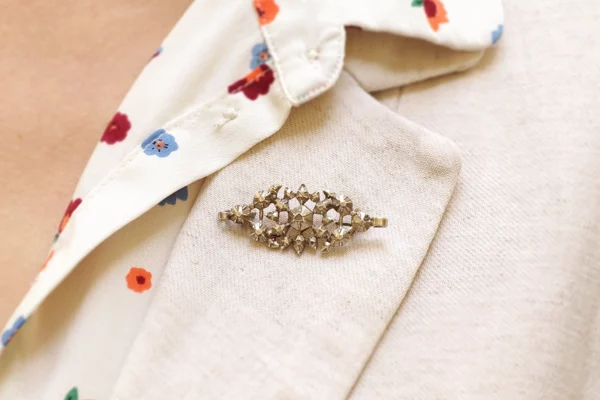
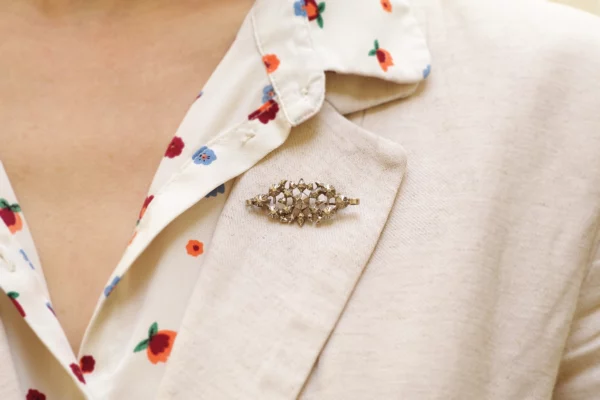 270,00€
270,00€Antique French silver diamond brooch from Arles. Antique regional brooch decorated with openwork motifs. The center of the brooch is adorned with a small diamond in a crumpled-effect setting, a motif typical of the South of France. The brooch is partially gilded on the reverse to prevent silver staining clothing. Antique regional brooch, France, late 19th century.
Height: 17 mm
Width: 4 cmCondition : scratches from use
Weight : 5.74 gr
